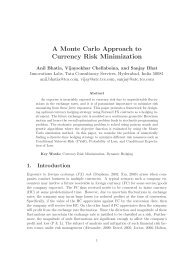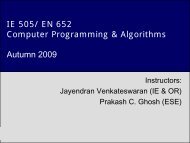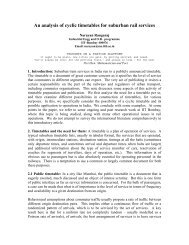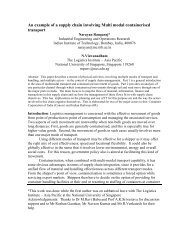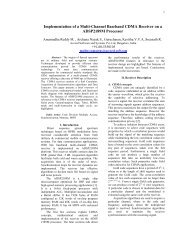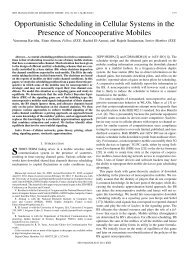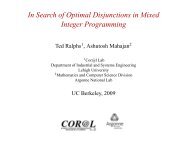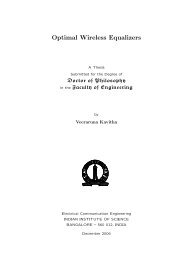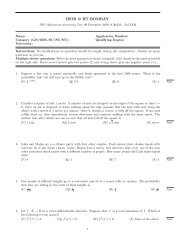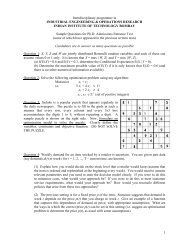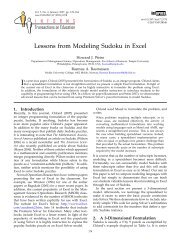Presolving Mixed-Integer Linear Programs - COR@L
Presolving Mixed-Integer Linear Programs - COR@L
Presolving Mixed-Integer Linear Programs - COR@L
Create successful ePaper yourself
Turn your PDF publications into a flip-book with our unique Google optimized e-Paper software.
<strong>Presolving</strong><strong>Mixed</strong><strong>Integer</strong><strong>Linear</strong> <strong>Programs</strong> ∗<br />
Ashutosh Mahajan †<br />
December 7,2010<br />
Abstract<br />
Wesurveythetechniquesusedforpresolving<strong>Mixed</strong>-integerlinearprograms(MILPs). <strong>Presolving</strong><br />
is an important component of all modern MILP solvers. It is used for simplifying a<br />
given instance, for detecting any obvious problems or errors, and for identifying structures<br />
and characteristics that are useful forsolving an instance.<br />
Keywords: <strong>Integer</strong> programming, presolving, preprocessing<br />
AMS-MSC2000: 65K05, 90C11<br />
1 Introduction<br />
<strong>Presolving</strong> or preprocessing techniques constitute a broad class of methods used to transform a<br />
given instance of a <strong>Mixed</strong>-integer linear program (MILP) or to collect certain useful information<br />
about it. The main aim of presolving techniques is to simplify the given instance for solving by<br />
the more sophisticated and often time-consuming algorithms such as cutting-plane or branchand-bound<br />
algorithms. Almost all modern solvers, both free (for instance, Achterberg, 2009;<br />
Forrest, 2010; Nemhauser etal., 1994; Ralphs etal., 2010) and commercial (for instance, FICO,<br />
2009; Gurobi, 2009; IBM, 2009), deploy these in one way or the other. Bixby etal. (2000) claim<br />
that presolving alone speeds the solution times on benchmark instances by a factor of 2. Another<br />
importantfunctionofapresolveristoanalyzethestructureoftheinstanceandcollectinformation<br />
that willbe usefulwhenthe problemis solved.<br />
<strong>Presolving</strong> is also useful for the purpose of modeling as it can be used to check the instance<br />
for obvious errors. It can, for instance, inform the user whether certain constraints or bounds<br />
on variables make the instance infeasible or whether certain variables will have arbitrarily high<br />
values (unbounded) in a solution. Such information can help the user improve the description of<br />
the instance and correct errors. It can also sometimes tell the user whether the values used in the<br />
model may cause numerical problems for the subsequent algorithms used by the solver. As such,<br />
∗ PreprintANL/MCS-P1752-0510<br />
† Mathematics and Computer Science Division, Argonne National Laboratory, Argonne, IL 60439,<br />
mahajan@mcs.anl.gov.<br />
1



